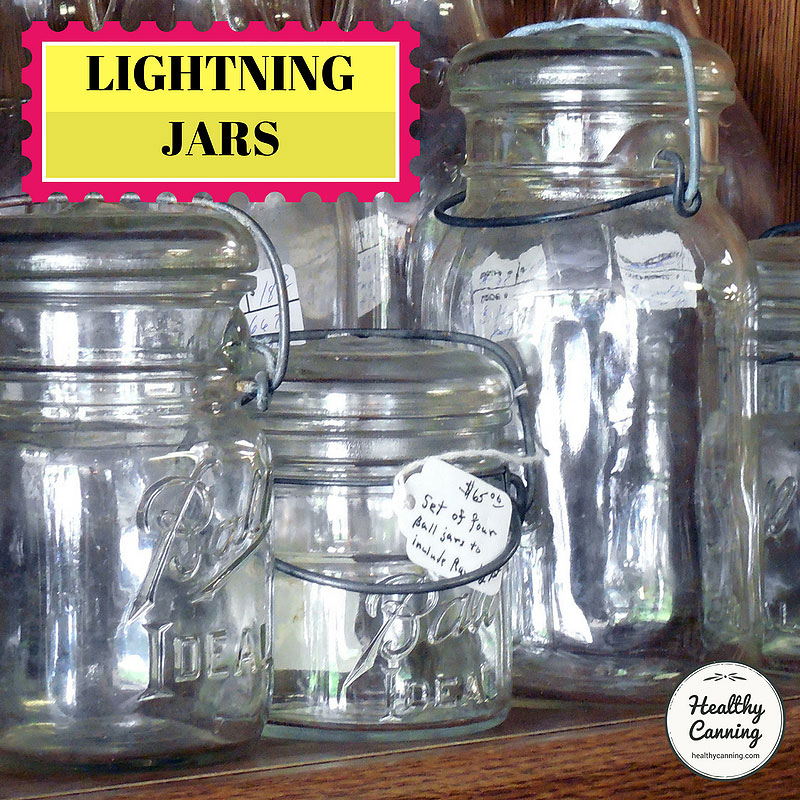A lightning jar was a type of jar made for home preserving in the first half of the 1900s.
These jars are now recommended against for home canning purposes. This article is for historical reference only. Do not attempt to do home canning with lightning jars.
What were lightning jars?
A lightning jar had a glass lid attached to the jar via two pieces of wire (referred to as “wire bails”), which acted both as a hinge and a locking mechanism for the lid. A rubber ring was used between the lid and the jar rim to actually effect a seal on the jar.
Ola Powell was an early educator in the field of home canning. Here’s what she wrote about the jars in 1919:
Lightning Seal.—The wide-mouth glass-top jar with wire clamp which is attached to the neck of the jar is a satisfactory one. A jar with this closure is known as one with a “lightning seal.” This seal is made by different manufacturers and put on the market under various trade names. A jar with this closure is an easy one to handle while the jar is still hot. Immediately after processing and sterilizing it is necessary only to push down the lower clamp around the neck of the jar. This gives the amount of pressure necessary to assist in the sealing of the jar as it cools. The rubber used is placed in the groove of the neck of the jar, and the cap fits down on the top of the rubber, which prevents the bottom of the glass top from coming in direct contact with the top of the jar. It is the rubber that makes possible this seal by adhering to both the top and the jar.” [1]Powell, Ola. Successful Canning and Preserving. Philadelphia: J.B. Lippincott. 1919. page 50.
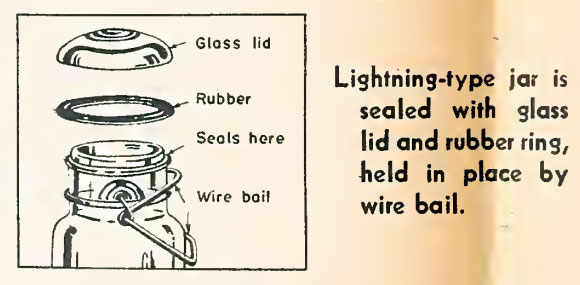
Home Canning of Meat. AWI 110. Bureau of Human Nutrition and Home Economics, USDA. Washington, DC. February 1945. Page 4.
The term “lightning” itself refers to the particular wire bail closure system invented by Henry W. Putnam, Charles de Quillfeldt and Karl Hutter. All three men got slightly different patents on it. The patents on the closure are thought to have expired around 1896, which then made its use available to various manufacturers. (That part of the history is actually quite complex and not anywhere near as simple as Wikipedia, etc, makes it seem, but untangling it is beyond the scope of this page: see Related Reading at the end for more info.)
The word was meant to conjure up in consumers’s minds how quick and easy it was to undo the lid and snap it back into place.
Problems with lightning jar wires
One problem with the jars is that the wire bails tended to lose their tightness. The Ball Blue Book said in 1943,
Loose or Worn Wires: The wires formerly used on all lightning type jars had a tendency to stretch after being used a few times. Never try to take up the slack in these old-fashioned wires by using two rubbers. Temporary tightening may be done by crimping the wires with pliers…” [2]Ball Blue Book Edition V. 1943. Page 5.
Oregon State College wrote about the problem in 1948:
[A] “Lightning” type jar has the same size rubber ring as standard mason, but the ring fits the ledge at the top of the jar. It has a glass lid held in place by 2 wire bails, one fitting in a groove in the lid. If the lid is too loose or too tight, remove the larger bail and bend it down or up in the middle until adjusted for a firmly tight seal.” [3]Gruetzmacher, Lucy Case, Thomas Onsdorff, and Mabel C. Mack. Canning for Home Food Preservation. Oregon State College. Federal Cooperative Extension Service. Bulletin 689. July 1948. Page 5.
Ball said that, really, the only effective remedy was simply to order new replacement wires:
….the only reliable remedy for loose or worn bail wires is new ones. They may be ordered from Ball Brothers Company, Muncie, Indiana. Postage prepaid price per dozen: 3 wires (2 bail and 1 neck) for Ideal Jars, 20 cents; 2 bail wires for Ideal Jars, 15 cents; 2 bail wires for Eclipse (wide-mouth) Jars, 20 cents. Price 5 cents higher west of Kansas City.” [4]Ball Blue Book Edition V. 1943. Page 5.
Ball eventually came out with a version, which it called the Ball “Ideal” jar, which was supposed to have solved the problem of the wires not lasting very long:
The Ball Ideal Jar is made of clear (flint) glass in pint, quart, and half-gallon sizes. It seals with a Ball Reliable Rubber and glass lid held in place by high tension wires which are scientifically treated so that they do not stretch from repeated use.” [5]Ball Blue Book Edition V. 1943. Page 5.
The Hazel-Atlas Co. released these visual directions for fixing bail wires:
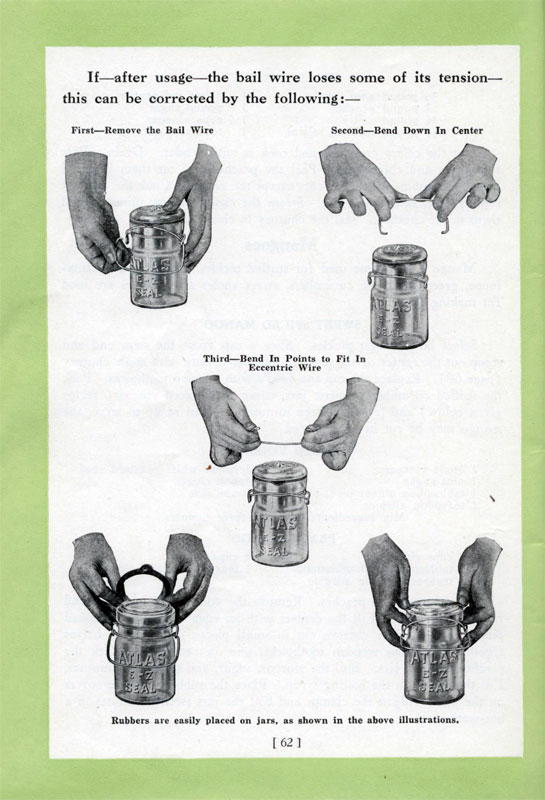
(Src: A book of recipes and helpful information on canning. Hazel-Atlas Educational Dept. c. 1920s / 1930s.)
Usage directions for the lightning jars
Here are Ball’s directions on how to practise using lightning jars:
Examine jars and lids. Test the tension of bails on old jars. An inexperienced canner, or one unaccustomed to using [lightning] jars, should heat used jars, fit with rubbers, fill with hot water, and seal immediately. Let jars stand until cold, then invert and examine for leaks. If there is no sign of leaks, it may be assumed that bails are tight.” [6]Ball Blue Book Edition V. 1943. Page 5.
The Montana Extension Service gave these directions in 1947 [7] Loughead, Mary E. Home Canning Meat Fish Poultry. Montana Extension Service in Agriculture and Home Economics. Bulletin No. 242. May 1947. Page 5. :
Lightning Jar: Glass lid and separate rubber ring held in place by wire bail.
1. Fit wet rubber ring in place on ledge at top of jar before filling jar.
2. Fill jar. Wipe top of jar and ring with damp cloth to remove food particles.
3. Put glass lid in place; bring the long bail up over the top of the jar and fit it into the groove on top of the lid. The jar is now partially sealed and is ready to go into the canner.
4. Complete the seal as soon as the jar is taken from the canner, after processing, by quickly pushing the short wire down.
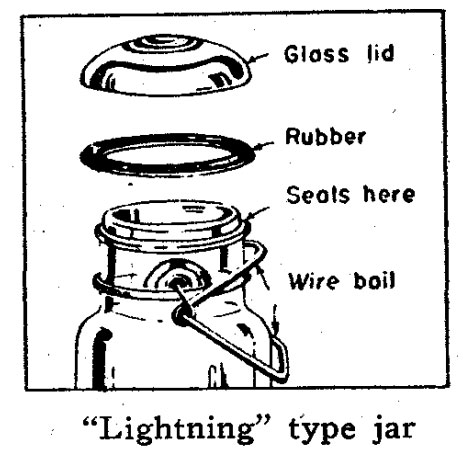
Image source: Gruetzmacher, Lucy Case, Thomas Onsdorff, and Mabel C. Mack. Canning for Home Food Preservation. Oregon State College. Federal Cooperative Extension Service. Bulleltin 689. July 1948. Page 5.
To test your seal after canning, you would loosen the latch, and attempt to lift the jar by the lid. If the jar lifted up with the lid, you had a good seal:
After fruits and vegetables are canned and set aside for 24 hours, lightning seal or hermetic jars may be tested by raising the clamp and attempting to lift the jar by the lid. If the lid comes off, the food may be fermenting. If the lid remains tight, the chances are that its contents are keeping.” [8]Creswell, Mary E. and Ola Powell. Home Canning of Fruits and Vegetables. USDA. Farmers’ Bulletin 853. July 1917; revised 1918. Page 7.
A fresh rubber ring was required for each time the jar was re-used for canning.
Problems with lightning jar seal-failure rates
Another problem with lightning jars is that they actually had a high seal-failure rate, resulting in very angry consumers.
There was actually some research done in 1935, showing a basic usage problem — that higher seal success rates could be achieved by locking the bail before processing rather than after — but we don’t know how well that knowledge was transferred from the lab out to kitchens at the time.
Lightning jars are phased out
The last mention we can find of the jars in the Ball Blue Book as being an acceptable home canning jar is in 1969.

Ball Blue Book, Edition 28, 1969. Page 11.
The jars just simply lost the battle to the two-piece lid style Mason jars (originally made by Kerr). These lids were less fiddly to use, and offered a far higher seal-success rate, especially after Kerr‘s innovation of the self-sealing metal lid for Mason jars.
Lightning jars today
Today, lightning jars can be used for attractive dry storage or for refrigerated storage.
You can buy replacement rubber rings on Amazon and elsewhere to help keep your dried items air tight, but we don’t know where you can get replacement bails today.
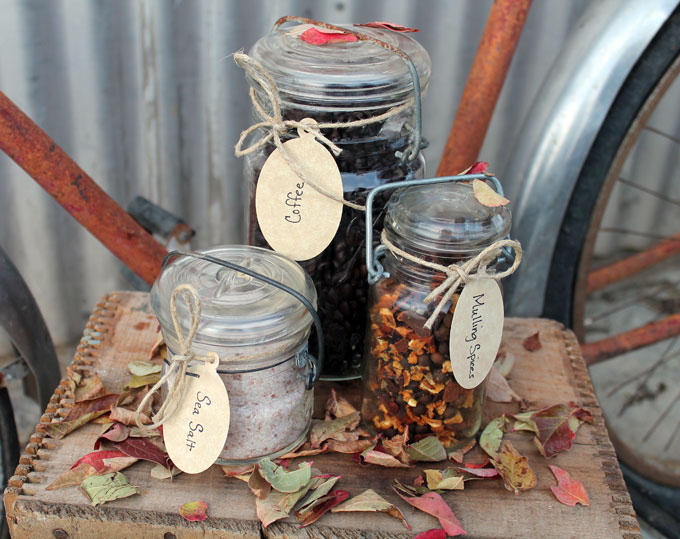
Bail jars being used for dry storage. Nina Nelson – shalommama.com / flickr.com / 2013 / CC BY 2.0
Related reading
For the (rather complicated) history of the fastener part itself, see: Bill Lockhart, Beau Schriever, Bill Lindsey, and Carol Serr. Henry W. Putnam and the Lightning Fastener. Updated March 2016.
References

